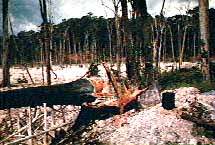|
|
© copyright 2003 Michael P. Hamilton, Ph.D.
July 27, 1987: There is nothing quite so stressful as driving a vintage Toyota Land Cruiser at high speeds for 10 hours straight along a pot-holed, mud-ridden, malaria-infested highway in Venezuela. To make our situation even more grueling, the outside temperature was an oppressive 105 degrees with 100% humidity, and every time I started to feel comfortable in my new role as driver, a campesino or his burro would jump out in front of our truck to test my reaction time and the poorly maintained brakes. For some reason I was designated as the only American crazy enough to drive because there were not enough Venezuelan professors and graduate students to drive our caravan. After spending a week in the mountains near Caracas, my students and I were now heading for the southern frontier of Venezuela, the gateway to the Lost World.
The last town on the highway we were traveling was named after the mileage marker - Kilometer 88 -- and it was the jumping off point for helicopters and four-wheel drive vehicles heading into the jungles of the Gran Sabana, the frontier border region of Venezuela and Brazil. Gold was being found all over, and no different from the gold-rush of California, Kilometer 88 was a "wild west" town as dangerous and exciting and depressing as any of those in the 1860's. It seemed liked almost everyone was packing a pair of "six-shooters" and a set of crossed bandoleers. We checked into the most secure hotel in town, which looked more like a prison with its barred windows, armed guards, and 12 foot tall security fences. There was a lot of money and gold in this place, and no one trusted the local policia to protect them from the abundant criminal element. Our rooms were beyond our worst nightmare, the cockroaches being at least as big as the radiation-mutated bugs I've seen on old re-runs of "The Outer Limits," and later that evening our hotel became the local bordello.
clear cutting the old growth rainforest near "Kilometer 88"
The next morning we planned to study several different tropical rain forest plant communities and to set up the bat nets, but not until we checked out one of the local mining operations. We were truly unprepared for the sight we viewed ... an enormous open pit mine nearly 1/2 mile wide was being enlarged by miners using giant hydraulic hoses shooting high-pressure water. The slurry of trees, soil, rock and water was sent through a series of wooden sluice-ways where highly toxic mercury was added to chemically bind with the gold and make it easier to remove the precious metal by filtration. Below the filtration area the milky-white effluent was directed into settling basins where men, women and children stood waste deep in the poisonous water as they sifted through the mud with gold pans. Exposure to mercury is a well-known health hazard that can result in severe birth defects. We were appalled by the use of mercury and the risks being taken by these workers and their families. Compounding the tragedy, the overflow from the settling ponds was directed back into the local streams and rivers! The downstream contamination of the rivers was sterilizing the aquatic ecosystem for many hundreds of miles.
The human and environmental tragedy that we witnessed put us all in a cloud of depression for the remainder of the day. Perhaps the Venezuelan government would crack down on the illegal activities, or perhaps there was so much money being made that politicians were being manipulated into looking the other way. The Venezuelan people were already on the verge of major revolt over their living conditions and the economic depression in the cities, so what would they care about a few thousand mercury-poisoned Indians, or the destruction of a major aquatic ecosystem? In this dangerous place, if you ask too many questions you might end up disappearing forever.
|



